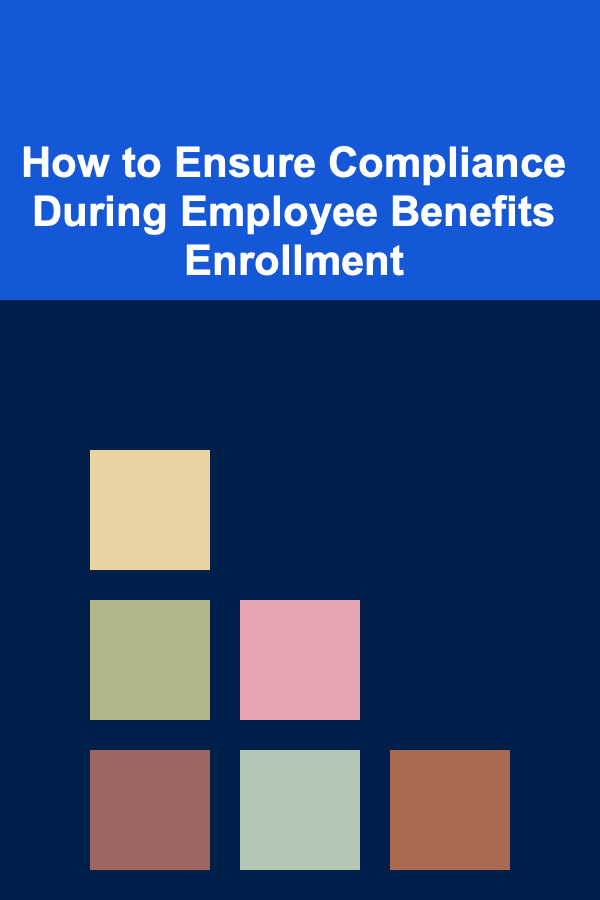
How to Ensure Compliance During Employee Benefits Enrollment
ebook include PDF & Audio bundle (Micro Guide)
$12.99$11.99
Limited Time Offer! Order within the next:

Employee benefits enrollment is a crucial aspect of the human resources (HR) process, impacting both employees and employers. It is the process through which employees select or modify their benefits packages, such as health insurance, retirement plans, paid time off, and other perks. Ensuring compliance during this process is essential for maintaining legal and regulatory standards, avoiding costly penalties, and fostering employee trust. This actionable guide outlines the steps and strategies you need to take to ensure compliance during employee benefits enrollment.
Understand the Legal and Regulatory Framework
The first step in ensuring compliance during employee benefits enrollment is understanding the various laws, regulations, and standards that apply to your organization's benefits offerings. These may differ based on factors such as the size of the company, location, and the types of benefits offered. The following laws and regulations are commonly relevant:
1.1. Affordable Care Act (ACA)
The Affordable Care Act (ACA) is one of the most significant pieces of legislation affecting employer-sponsored health insurance. Under the ACA, employers with 50 or more full-time employees must offer affordable health insurance that meets specific minimum essential coverage requirements. Failure to comply with ACA rules can result in penalties.
Key ACA compliance areas during benefits enrollment:
- Employer Shared Responsibility Payment: Large employers (with 50+ full-time employees) must offer health insurance that is affordable and provides minimum value, or they may be subject to a penalty.
- Reporting Requirements: Employers must report on health insurance coverage through forms like the 1095-C (for large employers) and 1095-B (for insurers).
1.2. Employee Retirement Income Security Act (ERISA)
ERISA is a federal law that governs employee benefit plans, including retirement plans, health benefits, and welfare benefits. ERISA mandates that employers adhere to specific rules related to plan administration, funding, reporting, and fiduciary responsibility.
Key ERISA compliance areas during enrollment:
- Plan Documents and Summary Plan Descriptions (SPDs): Employers must provide employees with plan documents and a clear SPD outlining the benefits they will receive.
- Fiduciary Duty: Employers must act in the best interests of plan participants and ensure plan assets are managed properly.
1.3. Consolidated Omnibus Budget Reconciliation Act (COBRA)
COBRA requires employers to offer continuation of health benefits to employees who experience qualifying events such as termination or a reduction in work hours. During benefits enrollment, ensure that all employees are informed of their rights under COBRA.
Key COBRA compliance areas during enrollment:
- Notification Requirement: Employees must be informed of their COBRA rights at the time of enrollment and when they experience a qualifying event.
1.4. Family and Medical Leave Act (FMLA)
The Family and Medical Leave Act (FMLA) entitles eligible employees to take unpaid leave for family or medical reasons without losing their job. Employees on FMLA leave may continue their health benefits, and employers must ensure that the enrollment process reflects their rights.
1.5. State-Specific Laws
In addition to federal laws, various states have their own regulations concerning employee benefits. For example, some states mandate paid family leave, while others may require additional health insurance coverage. It is crucial to stay up-to-date on local laws to avoid noncompliance.
Ensure Accurate and Timely Employee Communication
Clear, accurate, and timely communication is one of the most important aspects of ensuring compliance during benefits enrollment. Employees need to understand their options, their rights, and their responsibilities. Failure to communicate effectively can lead to misunderstandings and noncompliance.
2.1. Provide Detailed Benefits Information
Employees should receive a comprehensive overview of the benefits options available to them. This information should include the following:
- Benefit Plans Overview: Detailed descriptions of health insurance plans, retirement savings plans, paid time off (PTO), and other perks.
- Eligibility Requirements: Clear instructions on who is eligible for certain benefits, and how long they have to enroll.
- Enrollment Periods: Specify deadlines for open enrollment and any special enrollment periods due to life events such as marriage or childbirth.
- Costs and Contributions: Outline the employee's share of the costs for each benefit plan and explain how contributions are deducted from their pay.
2.2. Use Multiple Communication Channels
Leverage a variety of communication channels to ensure employees are aware of the enrollment process and deadlines. This can include:
- Emails with detailed instructions and reminders
- Virtual or in-person informational sessions
- Online portals with easy access to benefit details
- Printed materials for those who may not have access to digital tools
2.3. Offer Enrollment Support
Many employees may find the benefits enrollment process confusing or overwhelming, especially if they are unfamiliar with the available options. Offering personalized support, whether through HR representatives, online chat support, or a benefits hotline, can ensure that employees are well-informed and able to make the best decisions for their needs.
Implement a System for Tracking Enrollment and Documentation
Maintaining accurate records and documentation is essential for compliance, especially in case of audits or legal inquiries. Employers must ensure that they track employee benefits enrollment and have the necessary documentation to prove compliance with various regulations.
3.1. Electronic Enrollment Systems
Using an electronic enrollment system simplifies the enrollment process and reduces the likelihood of human error. These systems typically allow employees to:
- Select benefits packages online
- Confirm their selections
- Receive automatic confirmations and reminders
- View and download important documents such as plan summaries and benefit certificates
3.2. Maintain Detailed Enrollment Records
For compliance purposes, it is vital to retain records of employee benefit elections, including:
- Signed benefit election forms
- Acknowledgment of receipt of benefits information
- COBRA notices and related communications
- Employee communications about health plan options
3.3. Track Deadlines
Failure to adhere to enrollment deadlines can result in penalties. Tracking key dates and ensuring that employees complete their selections within the allotted time is essential. Many enrollment platforms will automatically alert employees of approaching deadlines.
Provide Ongoing Benefits Education and Training
Compliance is not limited to the initial enrollment period; employers must ensure ongoing education and training related to benefits. This is especially important when employees experience life changes, such as marriage, childbirth, or a change in employment status, that may affect their benefits eligibility.
4.1. Offer Annual Benefits Refresher Sessions
Even after the initial enrollment, provide employees with regular sessions that refresh their knowledge of available benefits, any changes to the plan, or updated legal requirements. This is especially important for employees nearing retirement age or those who may have previously waived certain benefits.
4.2. Stay Updated on Regulatory Changes
Laws and regulations regarding employee benefits can change. HR departments should stay informed of any new legislation or amendments that affect the benefits offerings. Regularly check government websites, subscribe to compliance newsletters, or work with legal professionals to ensure your benefits offerings remain compliant.
Regularly Audit Your Benefits Program
Regular audits are essential to verify that your benefits enrollment process is compliant with all applicable regulations. Auditing your benefits program ensures that:
- Employees are being enrolled in the correct benefits plans
- Your company is complying with ACA, ERISA, COBRA, and other applicable laws
- Benefits eligibility is being properly tracked and documented
5.1. Internal Audits
HR teams should periodically conduct internal audits to review benefits enrollment records, check for discrepancies, and ensure compliance with plan documents and legal requirements.
5.2. Third-Party Audits
Consider hiring external auditors or consultants with expertise in employee benefits compliance. Third-party audits can offer an unbiased review of your benefits processes and ensure that your practices align with industry best practices and regulatory standards.
Create a Contingency Plan for Noncompliance
Despite your best efforts, noncompliance can still occur. Having a contingency plan in place for dealing with issues such as missed deadlines, enrollment errors, or missed regulatory requirements can mitigate the impact. This should include:
- Immediate steps to correct the issue
- Communication with affected employees
- Procedures for paying any penalties or fines
- A process for preventing future issues from arising
Conclusion
Ensuring compliance during employee benefits enrollment requires a proactive approach, from understanding the legal framework to maintaining clear communication and tracking the enrollment process. By implementing a well-structured, organized system for benefits enrollment, training your employees, and staying updated on regulatory changes, you can protect your organization from legal issues while providing valuable benefits to your employees. Remember that compliance is an ongoing process, and regular audits, employee education, and timely adjustments are key to maintaining a smooth and compliant benefits enrollment program.
Reading More From Our Other Websites
- [Home Rental Property 101] How to Handle Rental Property Maintenance Issues Effectively
- [Home Party Planning 101] How to Plan a Virtual Game Night with Friends
- [Organization Tip 101] How to Store Unfinished Projects Neatly
- [Digital Decluttering Tip 101] From Clutter to Clarity: Minimalist Design Principles for a Calm Digital Environment
- [Home Storage Solution 101] How to Organize Your Kitchen for Efficient Meal Prep
- [Toy Making Tip 101] Eco-Friendly Play: Crafting Sustainable Toys with Everyday Materials
- [Ziplining Tip 101] High-Altitude Happiness: Incorporating Ziplining into Your Wellness Routine
- [Home Rental Property 101] How to Maximize Rental Income by Adding a Rooftop Terrace to Your Property
- [Home Staging 101] How to Stage a Kitchen Island for Real Estate Photos
- [Home Space Saving 101] How to Design a Small Kitchen That Feels Spacious

How to Assess Highland Pet Care for Your Pet's Unique Needs
Read More
How to Update Your Home's Lighting on a Budget
Read More
Smart Strategies for Minimizing Food Waste in Your Kitchen
Read More
The Research Scientist's Guide: Mastering the Art of Scientific Inquiry
Read More
Mastering the Neuroscience of Leadership
Read More
10 Tips for Building a Network as a Translator
Read MoreOther Products

How to Assess Highland Pet Care for Your Pet's Unique Needs
Read More
How to Update Your Home's Lighting on a Budget
Read More
Smart Strategies for Minimizing Food Waste in Your Kitchen
Read More
The Research Scientist's Guide: Mastering the Art of Scientific Inquiry
Read More
Mastering the Neuroscience of Leadership
Read More